Key takeaways
- Understanding light and weather conditions is crucial for capturing the unique moods of coastal landscapes, particularly during golden hours and foggy moments.
- Essential gear includes a sturdy wide-angle lens, tripod for stability, and protective equipment to safeguard against unpredictable coastal weather.
- Planning ahead with tide charts and potential photo locations enhances the likelihood of capturing stunning shots while being flexible with weather conditions.
- Post-processing plays a vital role in enhancing textures, adjusting colors, and refining images to reflect the emotional experience of the scene.
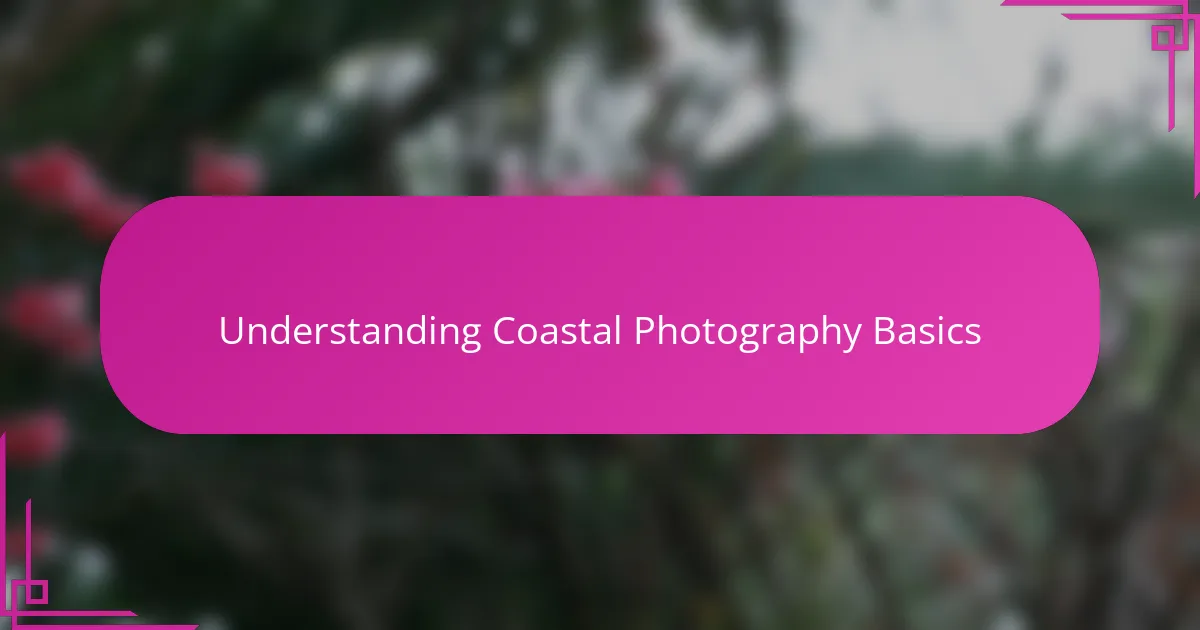
Understanding Coastal Photography Basics
When I first started photographing the Oregon Coast, I quickly realized that understanding the interplay between light and water was essential. The changing tides and shifting clouds create moods that can transform a simple scene into something truly captivating. Have you ever noticed how the same beach looks completely different at sunrise versus midday? That’s the magic of coastal photography.
One thing I learned early on is how important it is to manage exposure carefully. Water can reflect so much light that your camera might struggle to capture details without either blowing out highlights or losing shadow information. Adjusting settings like shutter speed and aperture becomes a balancing act, but it’s one that pays off when you capture textures in waves or wet sand just right.
Also, patience is key by the shore. I remember waiting for what felt like hours as the fog rolled in, softening the harsh lines and lending a dreamy quality to the landscape. Coastal weather is unpredictable, and embracing that uncertainty is part of the experience. It makes every shot feel like a small victory earned from observation and timing.
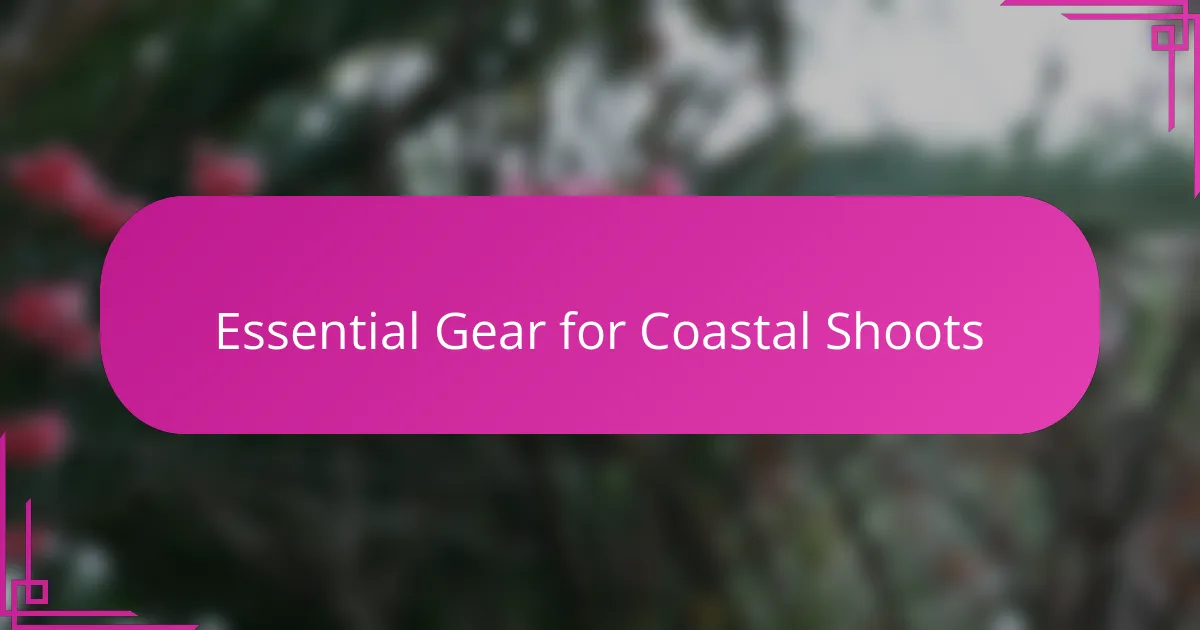
Essential Gear for Coastal Shoots
When I pack for a coastal shoot, my camera body and a sturdy wide-angle lens are my absolute must-haves. Have you ever tried capturing a vast shoreline without a lens that can embrace the scene? It’s tough—those wide vistas just don’t feel complete. I’ve learned that being able to get close to the crashing waves while maintaining sharpness makes all the difference.
A tripod is another piece of gear I rarely leave behind. Shooting long exposures to smooth out water or capture those silky waves requires solid stability. I remember one foggy morning when the light was fading fast; having my tripod allowed me to slow down the shutter speed and create that surreal, painterly look I was aiming for. Without it, I doubt I could have pulled off that shot.
Lastly, I always bring protective gear—lens cloths, rain covers, and even a weather-sealed bag. The Oregon Coast can turn from calm to stormy in minutes, and keeping my equipment dry and clean means I’m ready when the moment strikes. Have you ever been drenched by a rogue wave, only to worry about your camera? I have, and since then, I never skimp on protection.
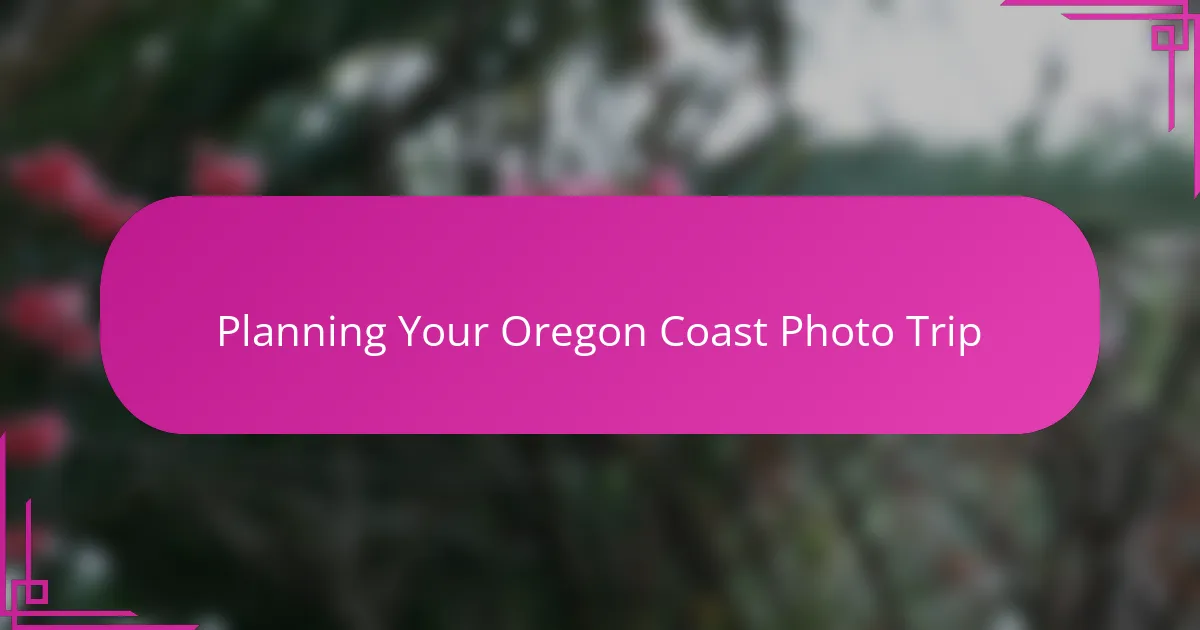
Planning Your Oregon Coast Photo Trip
Planning a trip to photograph the Oregon Coast means more than just picking a date. I always start by checking tide charts because low tide reveals incredible tide pools and exposed rock formations that disappear when the water rises. Have you ever planned a shoot only to find the best views underwater? Timing your visit around the tidal schedule really changes the game.
Next, I consider the weather forecast, but I try not to expect sun every day. The coast’s moody climate often brings dramatic fog and storms that add character to photos. I remember one afternoon when a thick fog rolled in suddenly, turning an ordinary seascape into something mysterious. Being flexible with your schedule lets you adapt and capture moments others might miss.
Finally, mapping out key locations ahead saves time and helps manage daylight hours. From Cannon Beach to Cape Kiwanda, I plot spots that offer varied perspectives and easy access. Do you prefer aiming for iconic landmarks or hidden gems? I like a mix—it keeps things exciting and lets me discover my own favorite views along this stunning coastline.

Choosing Ideal Locations on the Oregon Coast
Choosing where to shoot along the Oregon Coast felt overwhelming at first because there’s just so much beauty packed into every mile. I learned quickly that iconic spots like Haystack Rock at Cannon Beach offer incredible compositions, but sometimes the less-known coves reveal even more unique angles and moods. Have you ever stumbled upon a quiet beach that seemed untouched by time? That sense of discovery made my photos feel more personal.
I also realized that access matters just as much as scenery. Some of my best shots came from places reachable after a short hike or a stroll through dunes, where I could capture the coastline from eye-level or elevated viewpoints. One early morning, climbing a rocky outcrop gave me a sweeping panorama that no roadside pullout could match. It’s worth asking yourself: do you want easy access or adventure to find your perfect frame?
Finally, timing each location with natural elements is crucial. I once spent an entire evening photographing the tide coming in at a rugged headland, knowing that the changing light and water levels would define the mood. Choosing spots where you can witness this interplay—whether it’s tide pools revealing textures or cliffs framing sunset skies—makes every photo session feel like a thoughtful journey, not just a checklist. Have you found that kind of magic in your own coastal shoots?
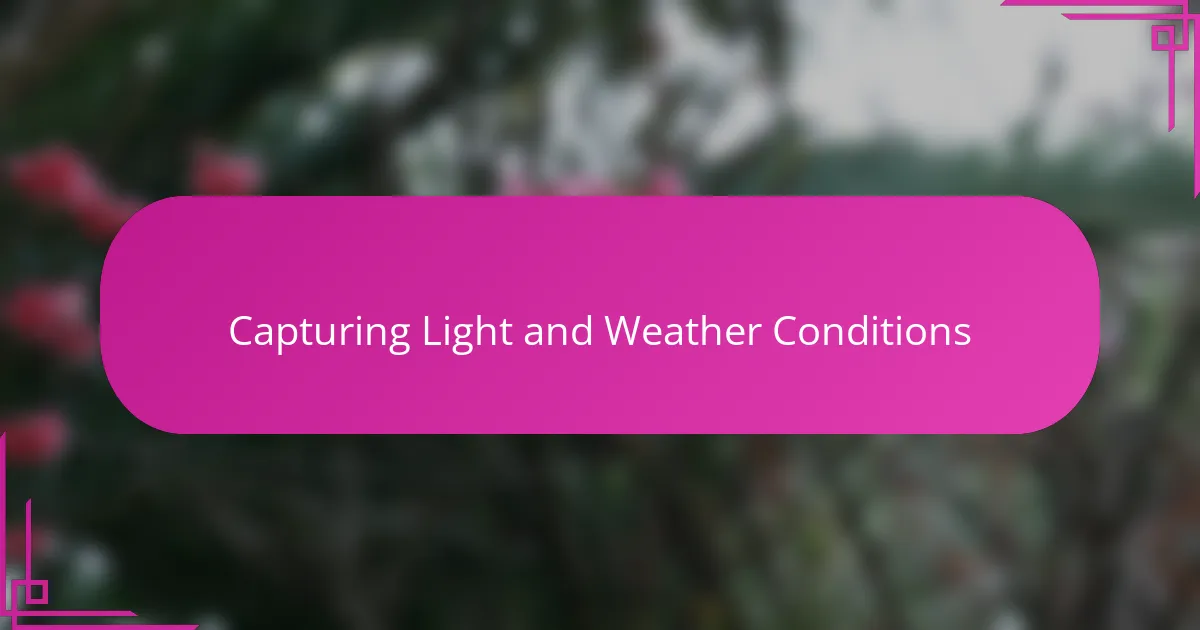
Capturing Light and Weather Conditions
Light on the Oregon Coast is a living thing—ever-shifting and full of surprises. I’ve found that the golden hours just after sunrise and before sunset offer that perfect, warm glow that makes everything feel almost ethereal. Have you noticed how the light softens the rugged textures of rocks and water during those times? Capturing that softness can turn a simple scene into pure magic.
The weather plays its own dramatic role. Fog, in particular, has been a game-changer for me. One morning, thick fog rolled in unexpectedly, wrapping the coastline in a gentle veil that softened edges and muted colors. It was like shooting in a dream, and I had to adapt fast to preserve that mood. How often do you get a chance to photograph a landscape that feels both mysterious and intimate at once?
Sunshine is great, but sometimes the moodiest photos come from overcast skies or stormy waves. I remember a day when heavy clouds loomed overhead, casting deep shadows and making the ocean look downright wild. By adjusting my exposure and waiting for bursts of light to break through, I captured shots full of tension and energy. Would you agree that embracing the harsher weather reveals a whole new side of coastal photography?
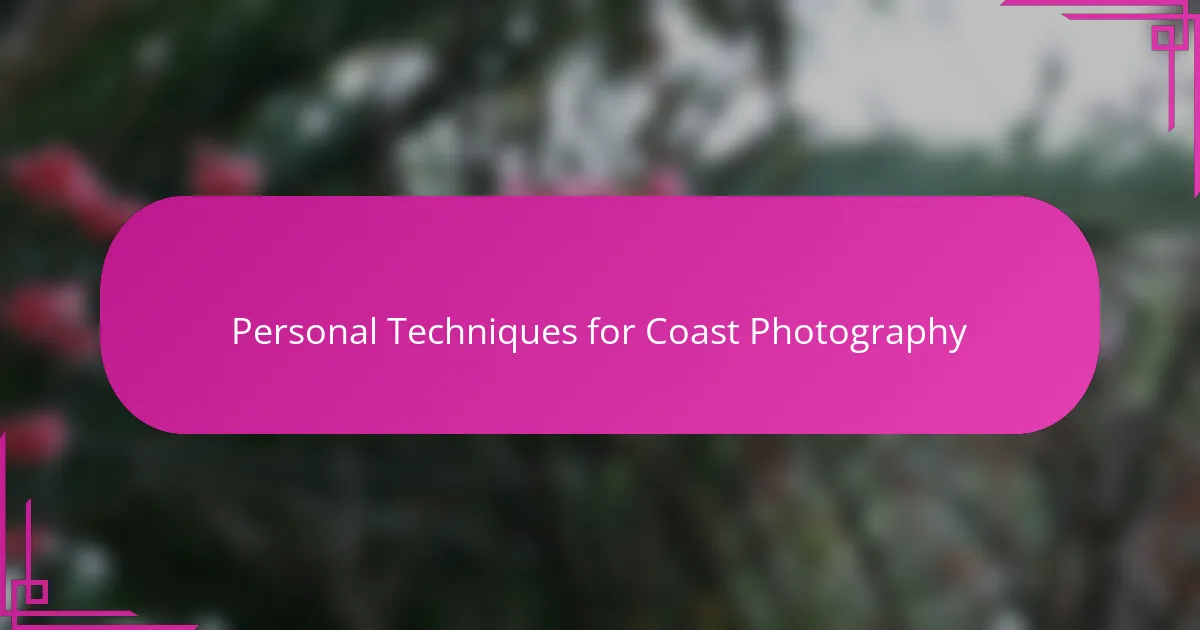
Personal Techniques for Coast Photography
When I photograph the Oregon Coast, one technique I rely on is using slow shutter speeds to blur the movement of waves, giving the water a smooth, ethereal quality. It’s amazing how a few seconds longer exposure transform crashing waves into gentle whispers of motion. Have you ever tried this? The results feel almost painterly, and it really captures the mood of the coast.
Another personal trick I’ve developed is framing shots through natural elements like driftwood or rock formations. It adds depth and leads the viewer’s eye into the scene in a way that feels inviting and immersive. Sometimes, I crouch low or shift angles to find just the right balance — it’s a small effort that pays off by turning a simple seascape into something more dynamic.
I also pay close attention to color contrasts, especially during those fleeting moments when the sky shifts from stormy gray to a burst of pastel pink or orange. Capturing that unexpected palette requires being ready and patient, even if it means standing in chilly wind for a while. Doesn’t it feel rewarding when your patience is rewarded with a sky that seems painted just for your shot? That’s the kind of moment that keeps me coming back.
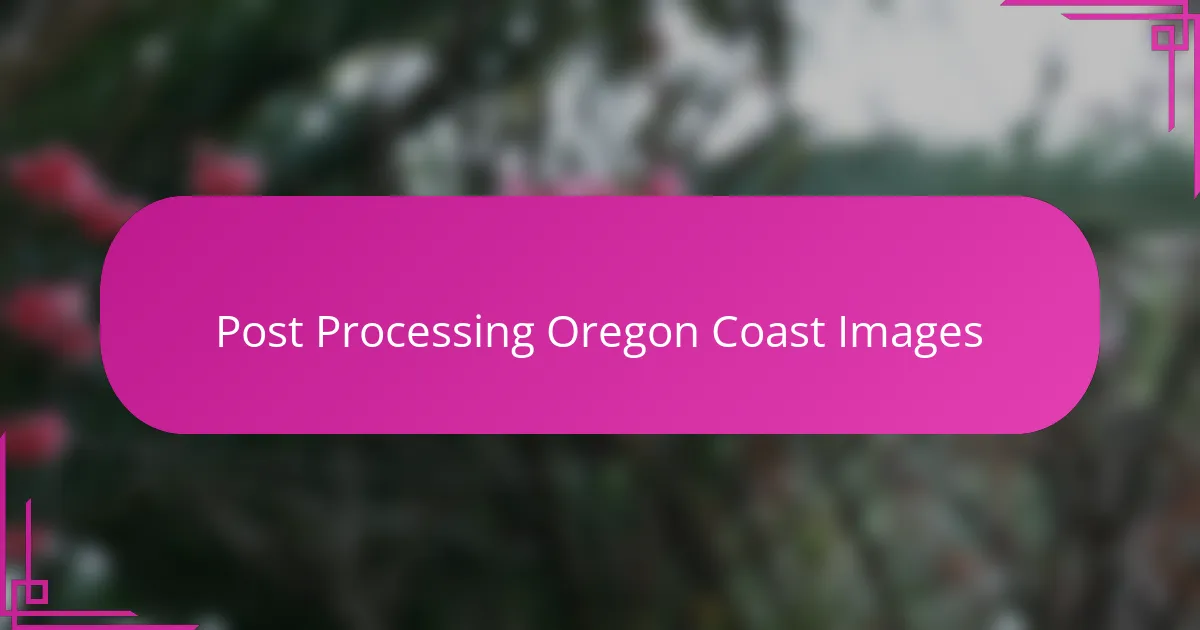
Post Processing Oregon Coast Images
Post processing my Oregon Coast images is where the magic really comes alive for me. I often spend time fine-tuning contrast and clarity to bring out the textures in the rocks and waves without losing the softness captured in-camera. Have you ever struggled with making sure the dark shadows don’t swallow details while keeping the highlights bright? It’s a careful dance that rewards patience and subtlety.
I also find myself relying heavily on color adjustments to reflect the mood I experienced right there on the shore. Sometimes, those cool blues and grays need a slight warmth boost to convey the golden light of a foggy afternoon or the glow just after sunset. Each photo feels like a story, and post processing lets me retell it with the emotion I felt when I pressed the shutter.
One technique I keep coming back to is selectively sharpening key elements like rocks or driftwood while leaving water areas smooth and dreamy. It’s a way to guide the viewer’s eye through the frame and recreate that immersive feeling I had standing by the ocean. Have you tried this approach? For me, it’s the subtle details in post that turn a good photo into one I’m truly proud of.